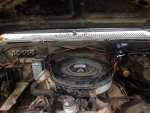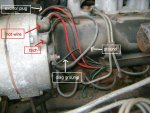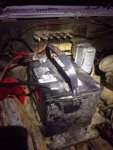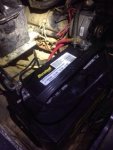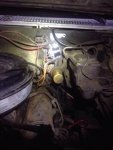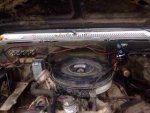Not to hijack, but read your thread (very interesting) and I'm curious if you happen to have the exact lengths of cables, fuse, etc. you ordered so someone could repeat your project in its entirety.
Two pieces of wire:
1 ea. 6' x 6 AWG Battery Cable Tinned Marine Grade Wire Red
1 ea. 18" x 4 AWG Battery Cable Tinned Marine Grade Wire Red (I would make this 24" instead)
Plus connectors.
The total order came to $24.68.
I ordered the cables from
http://www.bestboatwire.com/
The fuse & fuse block came from Amazon. The brand is.... not sure. One of the better marine brands. Electrical stuff is not a place to go cheap.
Did you ever rework the ziptied cable from the fuse to the battery?
Not yet. The truck hasn't moved! I've been chasing some other electrical gremlins and alternator problems and super busy. It's not my DD, and my DD has had problems, I've replaced a transmission on the wife's van, etc. etc. etc. Oh, plus getting in the firewood for the winter, etc. etc.

I plan to replace that 18" section. I'm going to re-route it to the front battery, and I need a few more inches. I'll encase it in corrugated loom where I plan to attach it to the battery holder.
I read the GP resistor bypass in the FAQ and your thread..but I'm not 100% sure I get the benefit here.
Is it to eliminate the complexity associated with the resistors converting 24v to 12v for the glow plugs and simply provide 12v to the GP directly and eliminating a potential failure point?
Not exactly. The stock system is what we call a "voltage divider circuit". When current flows along a path which has resistors in series, the voltage drops across each resister. How much it drops depends on the ratio of the resistors. For example:
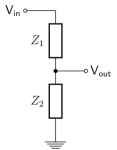
If the resistors are of equal value, the voltage at V-out will be 1/2 of the voltage at V-in. However, if the resistance at Z2 is
higher than Z1, the voltage at V-out will be
higher.
Well, it turns out that when we have resistors in parallel, the value of the total is LESS than the value of just one of those resistors. for example, if we have 10 resistors in parallel, and each one is a 10 ohm resistor, the total resistance will be 1 ohm. (That makes sense - there are more paths for the current to take simultaneously. It's like having more holes in a tank - more fluid will flow.)
That's what we have with our GP circuit. Each GP has a certain resistance, and
together they present a
lower resistance to the current than just one.
But take one GP out of the circuit (by burning it out), and now the total resistance is
higher than before (like plugging one of those holes in the tank). Whoops! What just happened to our voltage? It just got
higher. What does that do to our GPs? They are getting
more voltage, and therefore more current. They will age faster, and they will burn out sooner. What happens when the next one goes? Right, the total resistance is now
higher, and the voltage is
higher, speeding the demise of the remaining GPs. Then the next one, and the next one. Each failure creates a
higher voltage for the remaining GPs, which makes them burn out faster. Bang, bang, bang, bang. One after the other. This is why it's called a "cascade failure".
Take the voltage divider (the firewall resistor) out of the picture, and now all the GPs will ever see is 12v, no matter how many fail.
If you replace your GPs every time one fails, you'll never see this cascade failure, of course.
